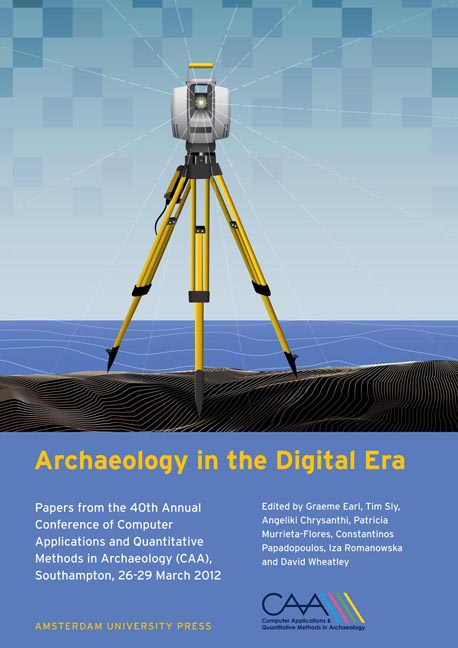 Archaeology in the Digital Era
Archaeology in the Digital Era A New Method of Spatial Analysis Based on the Extraction of Proximity Graphs
Published online by Cambridge University Press: 16 February 2021
Summary
Abstract:
This paper introduces the Relative Neighbourhood (RN) method of spatial analysis, a series ofprocedures oriented to extract relational networksfrompointsets, which canbe used to discover meaningful association patterns among archaeological artefacts or sites. The underpinning elements of such method are the relative neighbourhood concept, the retrieval of proximity graphs, the measurement of graph-theoretic relational properties both at global and local levels, and the visualisation of spatially-based connectivity patterns. The method is particularly useful to analyse a special type of archaeological deposits, which we refer to as “spatially symbolic contexts”. However, it is important to highlight that the method is generic and can be applied to many different kinds of archaeological contexts or even as part of studies focused on exploring relations between archaeological sites.
Keywords:
Proximity Graphs, Relative Neighbourhood, Spatial Analysis
Introduction
This paper introduces the Relative Neighbourhood (RN) method of spatial analysis, a series of procedures oriented to extract relational networks from point sets, which can be used to discover meaningful association patterns among archaeological artefacts or sites.
We illustrate the application of the RN method using a group of Aztec offerings, an interesting case of spatially symbolic contexts. These comprise groups of objects whose arrangement and meaning are determined by symbolic ideas expressed through the spatial ordering of different categories of artefacts. In such deposits, the specific location of each object -as well as its spatial association with the rest of the assemblage- creates characteristic observable ‘patterns’. In studying contexts like these, analysts seek to identify meaningful arrangements from the spatial links of the artefacts. The following section describes these deposits, while the remaining sections explain the concept of relative neighbourhood and the procedures to analyse global and local spatial features.
The Aztec Offerings as a Study Case for Spatial Analysis
For more than a hundred years Mexican archaeologists have discovered numerous caches of artefacts among the remains of the Sacred Precinct of Tenochtitlan, the main ceremonial centre of the Aztec people (Matos Moctezuma 1979, 1982, 1986, 1988). Nearly 200 deposits have been found so far (2012) within the boundaries of the archaeological site and some more in the surroundings.
- Type
- Chapter
- Information
- Archaeology in the Digital EraPapers from the 40th Annual Conference of Computer Applications and Quantitative Methods in Archaeology (CAA), Southampton, 26-29 March 2012, pp. 400 - 413Publisher: Amsterdam University PressPrint publication year: 2014
